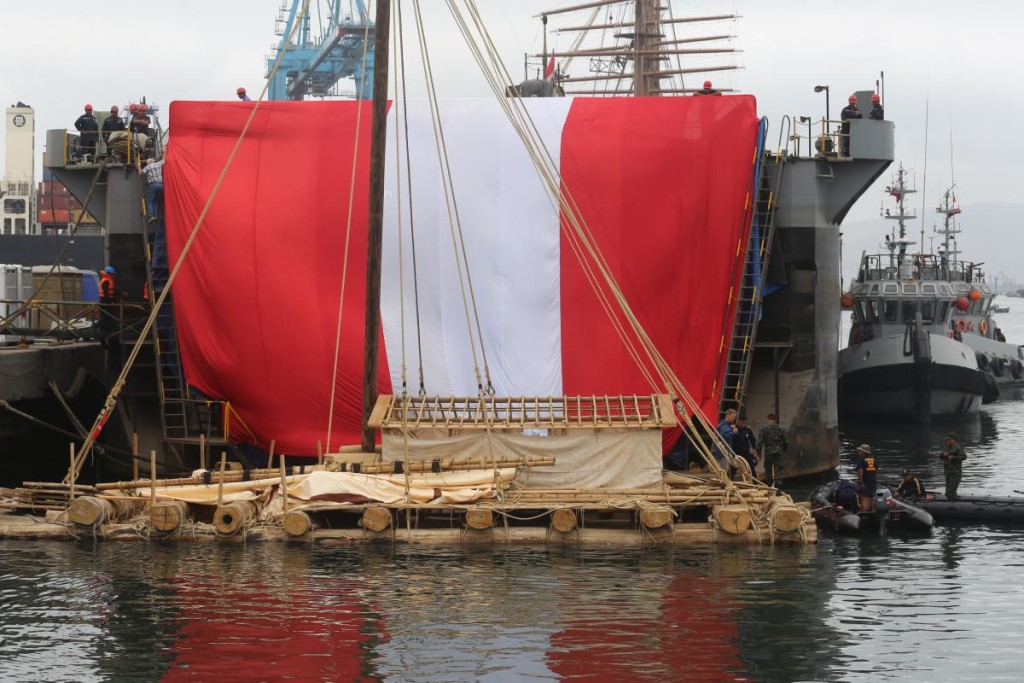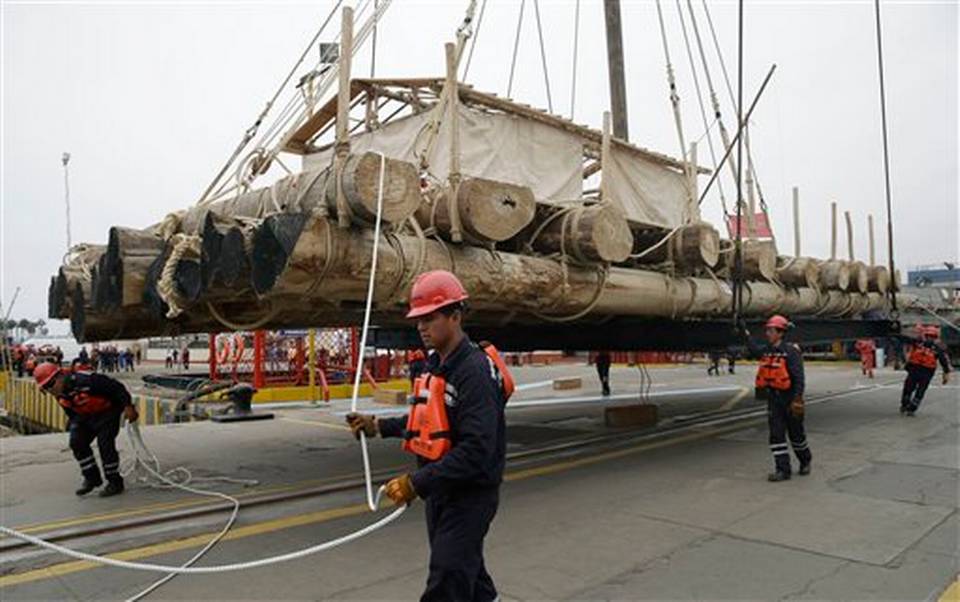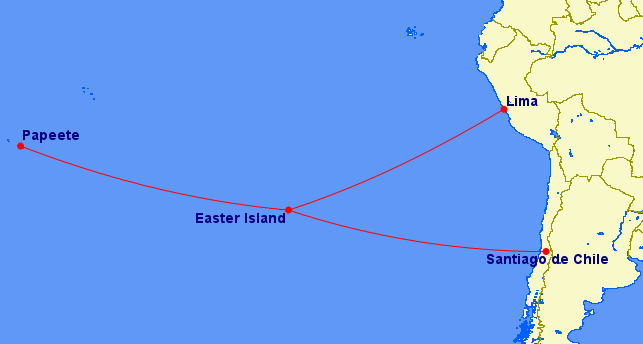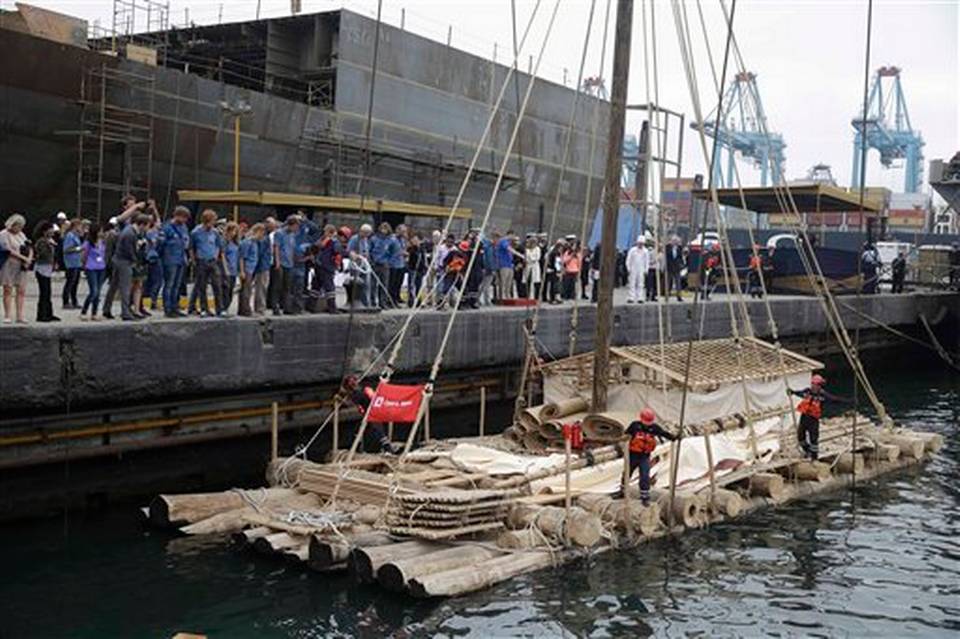Kon Tiki 2 Rafts Set Sail from Peru for Easter Island
posted on November 1st, 2015 in Kon Tiki Raft Voyage

The Kon Tiki 2 prepares for its maiden voyage in the port of Callao (Lima), Peru
Kon-Tiki Expedition Raft Trip Revived with Trip to Easter Island
Oct 29, 2015
El Comercio
(Translated by Kim MacQuarrie)
(Note: I met Thor Heyerdahl in 1988 up in Tucume, in northern Peru, as he was excavating among the Moche pyramids. I spent about three days helping him to clear the site and he was a very gracious host. One of the chapters in my forthcoming book, Life and Death in the Andes, addresses Heyerdahl’s voyages and theories and also chronicles my search for the reed boat builder who built Heyerdahl’s rafts for his Ra Expeditions. I found him still alive and well, 82-years-old, and living in a village alongside Lake Titicaca. I also investigate whether Heyerdahl’s migration theories were ever substantiated. Much has been learned since his 1947 raft trip from Peru to the Marquesas Islands).
Enthusiasm reigns among the members of the Kon Tiki II, an expedition consisting of two rafts bound for Easter Island from [the port of] Callao early next month. The crew of 14 hails from Peru, Norway, New Zealand, England, Russia, Chile and three other nations and emulates the modes of navigation used by the ancient Peruvians.
The two rafts are named the Tupac Yupanqui and the Rahiti Tane and were made with logs brought from Ecuador. The construction took a month in the company’s shipyard, the Industrial Marine Services (SIMA), located at the Callao Naval Base.

Like the original 1947 expedition, the balsa logs arrived in Peru from Ecuador
The expedition commemorates the adventurous spirit that accompanied the [original] Kon Tiki expedition in 1947, which also sailed by raft from Peru to Polynesia. One of the major differences between the expedition that departs on the 1st or 2nd of November will be that on the first trip a wooden rudder was used, while the current one will use waras, which are planks of wood [centerboards] inserted down through the raft’s bottom into the sea and [that steer the craft].
The exact date of departure of Kon Tiki II depends on the completion of the procedures that will be implemented on board and on the weather conditions, explained Admiral Cesar Linares Roca, General Director of Maritime Interests of the Peruvian Navy.
The other big difference from the 1947 expedition, which was led by the Norwegian Thor Heyerdahl, is that the current trip is not just one way.

Easter Island lies approx. 2,300 miles from Lima, Peru
“We will sail a total of 5 thousand nautical miles, 2,000 of which correspond to the journey to Easter Island. In total, the whole expedition will take between 4 and 5 months,” explained Torgeir Higraff, expedition leader of the Kon Tiki II and also a Norwegian .
For Admiral Linares, Kon Tiki II will serve to rediscover our roots as a country linked to the sea. “Through its maritime activities the culture of a country is reflected, and Peru is a maritime country. The expedition will allow us to see how the ancient Peruvians dominated [the art of] navigation,” said Linares.
THE TECHNOLOGY INCORPORATED
During the trip, seven people will ride on each raft. One raft will carry only men; the other will have a mixed crew. The food will be based on fish, dried preserves and cornstarch. The crews will also collect rainwater. Three additional expedition members will accompany the return.
While they will sail by means of wind strength and the directional capabilities of the waras, the rafts will also be equipped with modern technology: satellite communication and beacons will allow maritime authorities to monitor the trip. Admiral Linares of the Peruvian Navy explained that he has coordinated with the Chilean Navy to monitor the Kon Tiki II while the two rafts are in the waters of that country.
Each raft is 15 meters long and 7 meters wide and possess a load capacity of 20 tons. They will be ‘baptized’ before launching them in the sea. With the expedition will travel many scientists, particularly oceanographers, who will take samples of water temperature and carbon, among other variables. “Scientific observations of water will have special relevance because it will be during the El Niño” said Higraff, the director of Kon Tiki II.
Among the crew are four women. One is them is the Norwegian, Kari Dahl, captain of one of the rafts, who said she was very excited to be about to cross the Pacific Ocean. “Spending several weeks at sea is synonymous with tranquility,” said the navigator.
In 2006 another raft, called the Tangaroa, left from Callao to Polynesia [and successfully arrived in Polynesia, carrying the grandson of Thor Heyerdahl, Olav Heyerdahl]

One of the rafts in the Peruvian naval port of Callao, just outside of Lima
